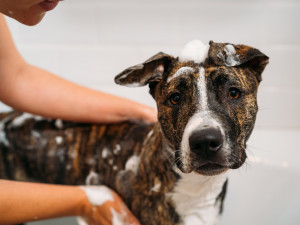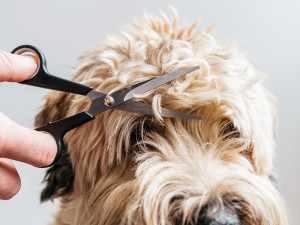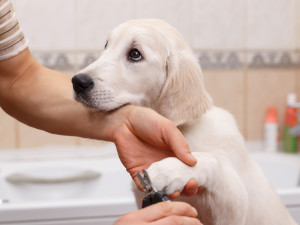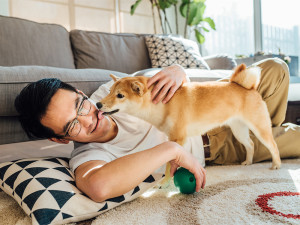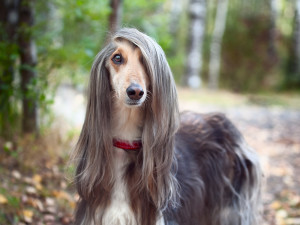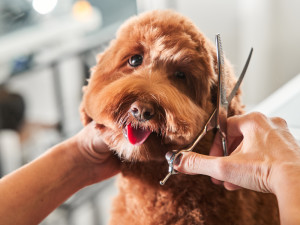When Can You Bathe a Puppy?
Squirmy puppy, shampoo, water—quite the adventure.

Share Article
In This Article:
When Can Your Puppy Have Their First Bath? How Often Should You Bathe Your Puppy? What Should You Use to Wash Your Puppy? How to Bathe Your Puppy Frequently Asked Questions
Puppies can typically be bathed starting at around eight weeks old. Use lukewarm water and a gentle, puppy-safe shampoo to protect their delicate skin. Ensure they are dried thoroughly to prevent chilling. Limit baths to once a month or as needed to maintain their skin’s natural oils and overall health.
When can your puppy have their first bath?
A newborn puppy typically has their hygiene taken care of by their mom with loving (and kinda gross) tongue baths. But when can puppy parents take over bathing duties?
Pet parents should wait until their puppy is at least eight weeks old before embarking on puppy’s first bath. Puppies have gained the ability to regulate their body temperature by this age. Otherwise, a puppy bath runs the risk of causing overheating or hypothermia if you're not extremely careful.

Depending on your puppy’s breed and fur type, puppy grooming may become a regular part of your pet care routine. If you plan to rely on professional groomers or public grooming facilities, wait until your puppy is completely vaccinated.
Being fully vaccinated means your puppy has completed the entire series of core puppy vaccines: multiple boosters of DAPP (distemper, adenovirus, parainfluenza, parvovirus) and one rabies vaccine. Your vet may recommend additional vaccines, like Bordetella, before using shared DIY puppy washing stations.
What do you do if your puppy makes a mess before eight weeks?
If a young puppy is in need of cleaning before they are eight weeks old, you can provide a sponge bath. Gently cleanse the dirty parts of the puppy with a cloth dampened with warm water. Don’t use soap or water. Promptly and thoroughly towel dry the puppy and be sure to keep them in a warm environment. If a young puppy needs a bath because of persistent diarrhea or external parasites, consult a veterinarian.
How often should you bathe your puppy?
How often you bathe your puppy depends on their hair coat type, fur length, and lifestyle, but plan for once a month or less. A long-haired dog that spends lots of time frolicking outside likely needs to be bathed more often than a short-haired dog that spends their time lounging inside.
Unless there’s a need for routine bathing to prevent matted fur or to maintain hygiene, bathing a puppy on an as-needed basis is totally fine. Bathing too frequently can strip off protective oils, leaving the skin and coat dry and flaky.
Occasionally, puppies may need more frequent bathing with medicated shampoos to address skin issues like bacterial infections and parasitic infestations. If your puppy has skin lesions, seek veterinary advice. If your vet prescribes a medicated shampoo, be sure to follow the directions closely.
What should you use to wash your puppy?
Before giving your puppy their first bath, gather all the necessary puppy bathing supplies and have a plan to help your puppy feel at ease. Having everything within reach prevents the urge to leave your puppy unattended while you grab a forgotten item. It also lets you focus on easing any puppy anxiety and making bathing a safe, pleasant experience.
Puppy bathing supplies include:
Safe location: Bathe your puppy in a place where you can have easy control of them and the water. A bathtub or large sink with a spray nozzle is ideal. Get a non-slip mat if needed.
Puppy shampoo: Be sure to use a shampoo that is made for dogs. Products formulated specifically for puppies are even better because they tend to be milder than adult dog shampoo.
Towels: Gather a couple soft, absorbent towels to promptly dry your puppy at the end of the bath.
Cotton balls: Cotton balls (not swabs) can be used to remove water from your puppy’s ears.
Treats
Washcloth
Puppy brush (optional)
Blow dryer (optional)
How to bathe your puppy
Bathing a puppy takes more care than lather, rinse, repeat. So, now that you have all your supplies, let’s get into the dos and don’ts of how to bathe a puppy.
What to do when bathing your puppy
Do introduce your puppy to their bathing area early on. Some puppies may be a little wary of cold, slippery bathtubs. Before using any water, place your dog in the tub and give them a few treats to teach them it’s not a bad place.
Do detangle your puppy’s fur if needed. Gently brush your puppy to loosen dirt and help prevent matting.
Do use the correct water temperature. Bathe your puppy in warm (not hot) water.
Do use a gentle puppy shampoo. Use a gentle massage to shampoo your puppy’s body. There’s no need to apply shampoo to your puppy’s face. Be sure to get between the toes for the double benefit of cleaning all the nooks and crannies and acclimating your pup to having their paws handled, which is great for future nail trims and vet visits.
Do use a damp washcloth to clean your puppy’s face. This makes it easier to avoid getting shampoo in your puppy’s eyes and water in their ears and nose.
Do rinse your puppy thoroughly. Residual shampoo can cause irritation and dryness.
Do dry your puppy thoroughly immediately after bathing. Gently rub them with a towel. To speed up the process, you can use a blow dryer on a low warm setting. Hold the blow dryer several inches away from your puppy and use constant movement to avoid focusing too much warm air in one place on their body. If the blow dryer stresses your puppy out, stick to towel drying. You can also try a calming capopens in new tab, which will help make the sound less intense.
Do remove water from inside your puppy’s ears with a cloth or cotton balls/rounds. Don’t use cotton swabs.
Do go slow. New sensations can induce fear and anxiety in puppies. Go at a pace that helps your puppy acclimate to the experience and give them reassurance.
Do give lots of praise, snuggles, and treats.
What not to do when bathing your puppy
Don’t use human shampoo. Human skin has a lower pH, fewer hair follicles, and a thicker outer layer than dog skin. The active ingredients in human shampoo can cause irritation and dryness. It can also disrupt the protective barrier that a dog’s skin provides, leaving a dog more vulnerable to bacteria and parasites.
Don’t let your puppy air dry. Puppies can get too cold after a bath if left to air dry, even during the warmer seasons.
Don’t use cotton swabs (Q-tips) to clean your puppy’s ears. Inserting a cotton swab into the ear canal runs the risk of causing trauma to the ear drum.
Don’t leave your pup unattended. Puppies can harm themselves through falling, inhaling water, or ingesting shampoo.
Don’t try to bathe multiple dogs at once. Just do one at a time to help keep things safe and calm.
FAQs (People also ask):
Can I shower my puppy?
A handheld shower nozzle allows better control of where the water goes when bathing your puppy. Avoid overhead showers to prevent water and shampoo from entering your puppy’s eyes, ears, and nose.
When should I bathe my puppy for the first time?
Puppies should be at least eight weeks old before they get their first bath. Eight weeks is when puppies can regulate their body temperature, reducing the risk for hypothermia during or after bathing.
How often should I bathe my puppy?
Puppies should be bathed once a month or less. How often you bathe your puppy depends on their coat and lifestyle. Bathing too often can strip away protective oils, leading to dry skin and coat.
References:

Dr. Alycia Washington, DVM, MS
Alycia Washington is a small-animal emergency veterinarian with over 10 years of experience based in North Carolina. She works as a relief veterinarianopens in new tab and provides services to numerous emergency and specialty hospitals. She also works as a veterinary writer with a focus on educating pet parents.
Related articles
![The-Wildest_Editorial_Puppy-grooming-tips_Hero_1000x750_v01.jpg]()
How to Groom Your New Puppy
Celebrity dog groomer Jess Rona’s puppy grooming pro tips.
Why Does My Dog Stink? Tips for Smelly Pups
Help! Why does my dog smell so bad?
![A person giving a dog a bath in a bathtub.]()
Tips on How to Brush and Bathe Your Dog from a Pro
Groomer extraordinaire Robyn Michaels explains best brushes and how to keep your pup well-groomed.
![A afghan hound standing in the woods with long silky hair.]()
The Best Dog Shampoos of 2025
It’s time for a self-care day.
![goldendoodle being groomed]()
Hair of the Dog: Breeds With High-Maintenance ’Dos
From shaggy Sheepdogs to curly Cocker Spaniels, a groomer lists 10 breeds that need the most upkeep.

